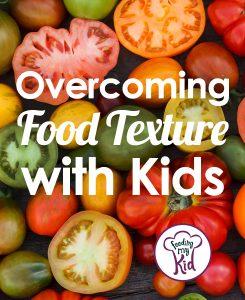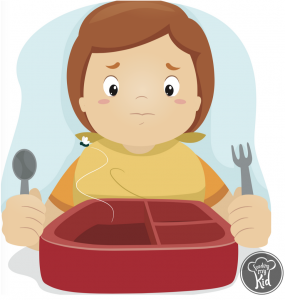 Food texture describes a food’s consistency, whether a food is lumpy, smooth, thin, thick or a combination of all these things.
Food texture describes a food’s consistency, whether a food is lumpy, smooth, thin, thick or a combination of all these things.
It’s normal for kids to be cautious about trying new foods. It’s actually evolutionary. Most toddlers will go through a phase where they are leery of new foods and different textures.
Is your child’s sensitivity to textures not allowing him to eat a large variety of foods?
Even if your child is gaining weight normally, he might still have nutritional deficiencies, depending on how many food aversions and/or sensitivities your child has. Pediatricians recommend looking at what a toddler eats over the course of a week to gauge if the child has had a good variety of foods in his diet.
In this article, we will walk you through ways to get your child to be comfortable with a larger variety of food textures.
Check Out More Kids Recipes Here:
- Cooking with Kids: Creative Ideas to Get Your Kids in the Kitchen
- Crispy, Oven Roasted Cauliflower Recipes. Get Your Kids to Love Cauliflower with These Recipes
- 20 Fun and Classic Birthday Party Games for Kids. They’ll Have a Blast!
Ways to Start Working on Reducing Food Sensitivity
Gateway Foods
Take an audit of the food your kids love. You can build on these foods by offering slight variations of the food. Let’s say your child loves chicken nuggets. Start offering different brands of chicken nuggets that have similar shapes and then get a brand that has them in completely different shapes. Then start offering homemade chicken that’s breaded similar to the chicken nuggets. And, then try breaded fish. Keep going and do this with all of their favorite foods.
Over time you’ll be expanding their diets using their favorite foods to do it. Make sure you take a few days off before offering similar foods. You don’t want them to get in the habit of eating the same food every day, even if you are using these foods as a gateway. The rule is at least one day apart, if you can.
Here is a great resource to help you track what foods your kids love and variations of the food. This is from Melissa d’Arabian, Chef/TV personality from the Food Network’s Picky Eaters Club. It’s an informative series from the Food Network.
Don’t forget to track your wins and opportunities, as suggested by the Picky Eaters Club series. You might be surprised by your accomplishments if you start tracking them. Each time my little man eats a new food, I secretly high five my hubby and then write down the win! Slowly, but surely, we are making progress.
Work with the Same Textures
Some kids love crunchy foods, while others have aversions to them. It’s important to start small, so work within your limitations. For example, if your child doesn’t like crunchy foods, then don’t shy away from putting all sorts of different kinds of foods and flavors through the food processor. This way your child still gets the flavor profile of foods, even if it’s not the same texture.
Get creative and work with your child’s texture aversion. If your child doesn’t like mashed potato, try potato wedges. Keep introducing some of the same foods in all kinds of different ways using different preparations. Think of all the different shapes and sizes French fries come in. Try them all with your little one.
Build on What they Love
Then also try sweet potato fries, parsnip fries and turnip and carrot fries. Personally, I bake them with garlic or cinnamon. I am building on how my kids love the French fry shape. This is how you expand their palates using gateway foods mentioned above.
If your kids don’t eat meat, puree it and then mix it with a strong flavor that your child does like. Slowly take down the complimentary flavor as low as low as he will let you. This way he can become accustomed to the flavor of the meat. It’s important to get him used to the flavors as you are working with him to overcome his texture aversions.
Over time, try pureeing the food less, and less leaving more texture each time. Or cut up the food in small bites. Go slowly. This is hard! To me it feels like a part-time job, but I know it will be worth it in the end. I want to set up my twins to be good healthy eaters later in life. I want them to travel the world tasting everything; ultimately, I want them to be adventurous eaters.
Relate this Process to Teaching Your Kid to Read
Teaching your kid to read can be hard. If he doesn’t get reading right away, you wouldn’t say ‘oh, well, he doesn’t like to read so I’m going to stop reading with him.’ Unfortunately, that is what happens with so many parents when it comes to getting their child to eat healthy. If their child doesn’t eat his vegetables, why give up on serving vegetables? Practice, practice, practice.
I know it can be a viewed as a waste of money and effort. You can make a bunch of vegetables and freeze them. Then every day take another vegetable out of the freezer and unfreeze it and serve. This way you can reduce your effort and food waste by only serving a small amount. Your child is never going to learn to like to eat vegetables if you do not constantly work with him on it. You are teaching taste and it is challenging, but so is potty training and learning to read. It’s tough!
Lower Your Expectations
This process is extremely challenging for both the parents and their child. It’s important for you to know this is hard and stressful for your little ones too. Do your best to be neutral through all their food aversions and texture issues. Your children need your love and support at this time, no matter how frustrating this is.
Kids can be very sensitive to texture changes, so it’s important to go slowly. Kids are just figuring out what foods taste like and are naturally cautious about new foods.
If you go too fast or are impatient with your child, then he can actually develop a fear of certain foods, textures, whole food groups and/or certain colors of food.
Working Through the Steps Slowly
Encourage your child to play with his food. This can get messy, but that’s good! There are so many steps that can happen before a child even eats the food. As adults, we are able to look at a food and can relate that food to something we have already tasted in our lives or related it to another food that looks like it. We can quickly anticipate what the food will taste like. Young kids can’t do that.
Some kids need countless exposures before even considering to touching a food. Great, now the child touched it!
The next step is putting it to their lips, and that should take another few exposure opportunities. Some kids might start eating it from this point, but others might need to put it to their lips, taste it and spit it out a few more times.
And then… finally… he eats it! It can still take some more exposures before the child starts to really like it. It’s an exhausting journey, but don’t give up! You are helping your child to develop his taste buds and flavor preferences that he will have for the rest of his life. I can cite countless studies that show how children’s taste buds are constantly developing, so don’t get worried if he makes faces or tells you he doesn’t like it now. If you keep exposing it to him, his preferences can change and he can grow to like it over time.
The good thing is that if you can get him to like the food before high school, then he will probably like the food as an adult. So, yay!
Tip: Always offer at least one safe food that he is used to eating with each meal when offering a new food. This takes the pressure and stress of having to try the new food.
Sensory Play
Sensory play can help your child overcome their texture aversion. This is a great opportunity for your child to look at food and to touch it without the stress of having to eat it. Kids learn through play and these sensory activities allow him to get more comfortable with the textures without the stress of having to eat the food.
Some kids are sensitive to crunchy foods and others to soft or slimy foods. My son has a texture aversion to slimy foods, which includes most fruits and vegetables. The other day he ate a grape and I was over the moon! We do play with water beads on a daily basis to help acclimate him with how slimy things feel.
Check out our Pinterest board about using sensory boards to overcome texture aversion.
Watch our videos on cold sensory play and spaghetti sensory play. Both of these play activities focus on your child getting more comfortable with touching a larger variety of textures.
Make it fun and use imaginative play. Can their toys go marching through a kale forest or have a woolly mammoth sinking through a penne sand trap? Share your fun, creative activities in the comments below.
Try Using Support Tools
The next step might be to introduce a variety of condiments and extra tools. Try putting out dips for your kids like ketchup, mustard, soy sauce, hot sauce, ranch dressing and other dressings. Try hummus and other healthy dips too. Keep trying to find what works for your little one.
Introduce toothpicks, forks and spoons. Only introduce toothpicks to a child that can handle them safely and make sure you are watching them at all times. These tools can reengaged them back into trying new foods and distract them a little from the pressure of trying new foods as he plays with these support tools.
Let Them Get Hungry

Toddlers are a lot more open to trying new foods if he is hungry. Manage their snacks and fluids so that he can have a healthy sense of hunger before a meal. If dinner is usually your most successful meal, then that’s the meal you should use to try a new food or texture. If breakfast is your worst, try to steer clear of offering new foods during that meal.
Oversensitivity to Oral-Sensory Input
If you oral sensory insitivity is standing in the way of him eating a large variety of foods, he might have oversensitivity to oral-sensory input. This is commonly associated with other diagnoses such as ADD or as a stand-alone diagnosis of sensory-processing disorder.
If you are concerned that your child has more than normal pickiness, please contact your Pediatrician to see if your doctor has any suggestions or if she can write you a referral to a specialist in your area.
Eating requires so many different skills for kids that we as adults take for granted. Your child needs to be able to swallow food, chew, move his tongue and food around from side to side, and have enough jaw strength to break up pieces or grind food depending on their age. Children can get hung up on anyone of these physiological challenges, which can cause their texture sensitivity to be worse.
My son had and has many of these issues. We go to therapy to help retrain his tongue on how to move food around his mouth and chew using his back teeth. Children have to learn how to do all of this and build the right muscle memory.
Share your thoughts
What’s worked for you? What hasn’t worked? Share your story of accomplishment or your struggle. We are all here to support each other!
